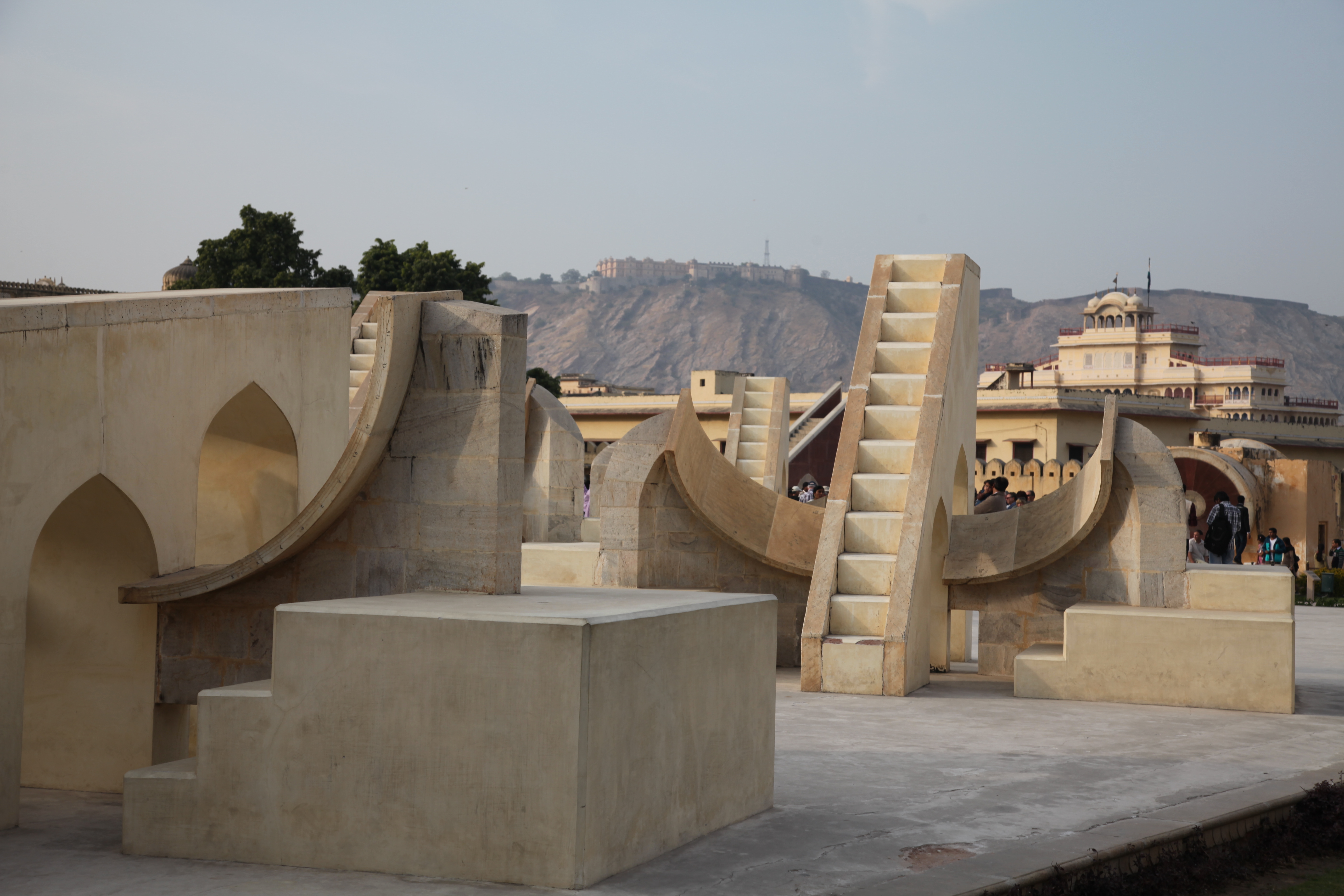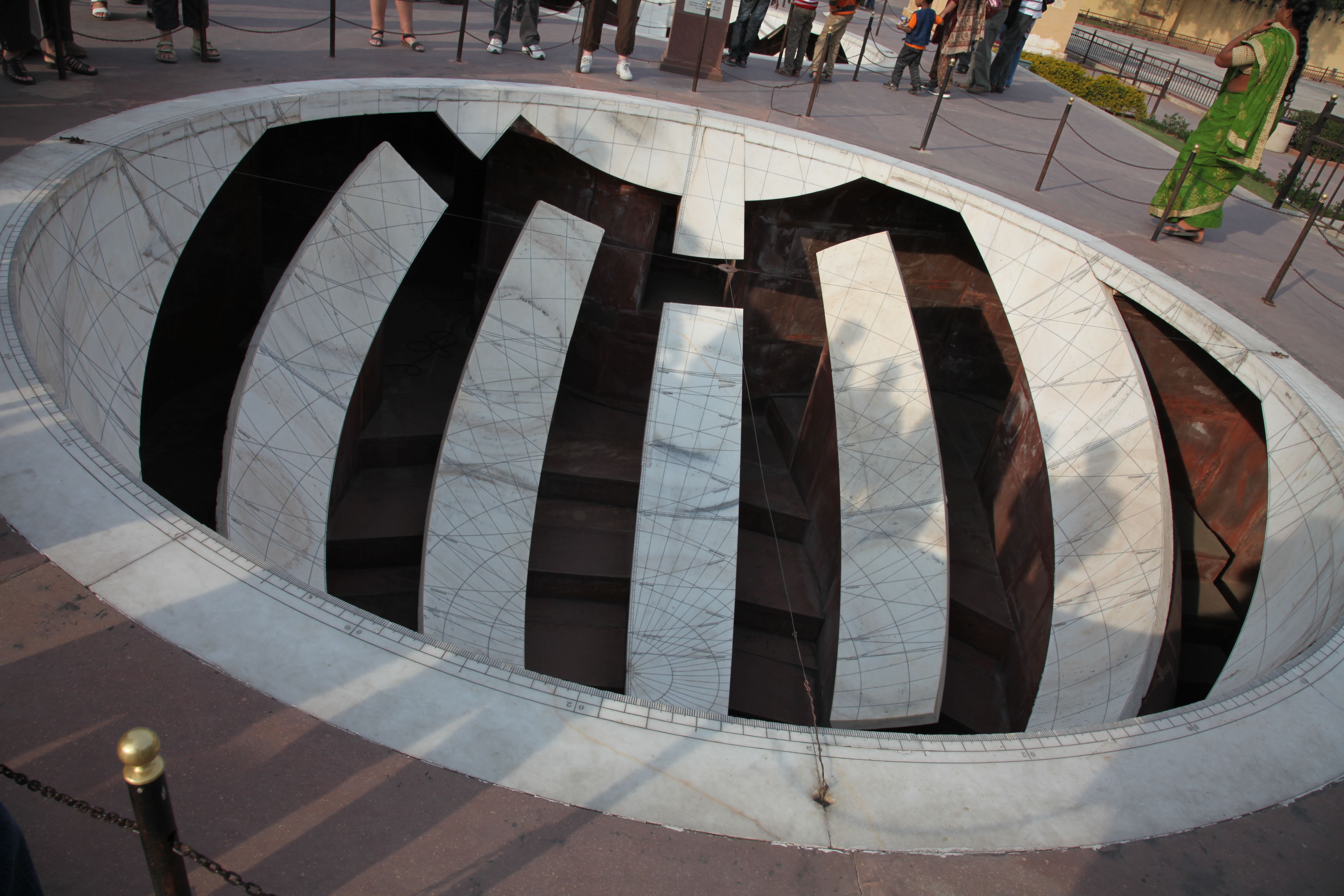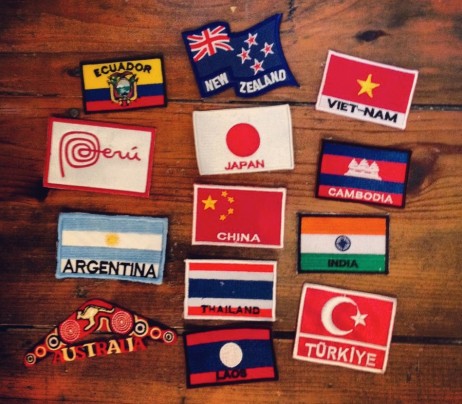 This is the Samrat Yantra, which means the Supreme Instrument. It stands 27 meters tall with its shadow moving visibly at 1mm per second making it the world’s largest sundial. Checking it against the clock on our phones, the time on this sundial is remarkably exact — and it’s so large that you can literally watch time moving across the curve of its plane.
This is the Samrat Yantra, which means the Supreme Instrument. It stands 27 meters tall with its shadow moving visibly at 1mm per second making it the world’s largest sundial. Checking it against the clock on our phones, the time on this sundial is remarkably exact — and it’s so large that you can literally watch time moving across the curve of its plane. The Samrat Yantra stands in Jaipur, India as part of the the Jantar Mantar which is an extraordinary collection of astronomical instruments built between 1727 and 1734 by Mahraha Jai Singh II, a young Indian king with a profound love of astronomy. The observatory consists of more than a dozen enormous geometric devices used for measuring time, predicting eclipses, tracking stars’ location as the earth orbits around the sun, figuring out the declinations of planets, and determining the altitudes of the stars.
The Samrat Yantra stands in Jaipur, India as part of the the Jantar Mantar which is an extraordinary collection of astronomical instruments built between 1727 and 1734 by Mahraha Jai Singh II, a young Indian king with a profound love of astronomy. The observatory consists of more than a dozen enormous geometric devices used for measuring time, predicting eclipses, tracking stars’ location as the earth orbits around the sun, figuring out the declinations of planets, and determining the altitudes of the stars. The Jantar Mantar is now a UNESCO World Heritage Site, and it was easily one of the most interesting scientific destinations on our whole trip so far.
The Jantar Mantar is now a UNESCO World Heritage Site, and it was easily one of the most interesting scientific destinations on our whole trip so far.
THIS IS WHAT IT IS
HOTELS ARE LIKE A BOX OF CHOCOLATES
We’ve slept in over one hundred different beds so far. Many of them have been apartments, some have been cramped quarters on ships, other have been sleeper bunks on overnight trains, and a few of the best have been guest rooms belonging to friends or acquaintances. We live our lives surfing airbnb.com and hotels.com, trying to figure out the next place to lay four weary heads. We’ve very serious about our accommodation budget (under $200 a night), so every time we show up somewhere it’s a bit of a crap shoot. We’ve paid far too much for some very scary rooms (Agua Caliente, Peru) and fallen madly in love with places we’d never heard of (see Franny’s love song to our loft in Fitzroy, Australia). So every time we turn the key in a lock, we’re never quite sure what’s on the other side. In Jaipur, India, we encountered a heavy brass lock unlike any we’d ever seen before. Open it with us.
OUR ALWAYS EVOLVING ITINERARY
 The first half of our around-the-world journey followed a relatively fluid line through South America, Australia and New Zealand, up into Asia, and across to India. We think of it like a well-orchestrated piece of music. The second half of the trip is shaping up to play much more like jazz. We have far fewer reservations made, we’re going to be much more improvisational, and instead of traveling from one continent to the next, we’re going to enter and exit Europe several times, traveling to the Middle East and heading down to Africa on two separate occasions. It was originally our plan to spend the new year in Israel, but the conflict that erupted there in November forced a change of course that had us traveling to Turkey in late December, then finding our way to Barcelona where we are currently hunkered down, plotting our adventures for 2013.
The first half of our around-the-world journey followed a relatively fluid line through South America, Australia and New Zealand, up into Asia, and across to India. We think of it like a well-orchestrated piece of music. The second half of the trip is shaping up to play much more like jazz. We have far fewer reservations made, we’re going to be much more improvisational, and instead of traveling from one continent to the next, we’re going to enter and exit Europe several times, traveling to the Middle East and heading down to Africa on two separate occasions. It was originally our plan to spend the new year in Israel, but the conflict that erupted there in November forced a change of course that had us traveling to Turkey in late December, then finding our way to Barcelona where we are currently hunkered down, plotting our adventures for 2013. Double-click the image above to see where we have been and where we are going. You’ll notice some exciting new additions that weren’t on the previous itinerary — specifically Greece, Kenya and Iceland. While nothing is set in stone and there’s much improvisation to come, here’s the very rough shape of the second half of our journey:
Double-click the image above to see where we have been and where we are going. You’ll notice some exciting new additions that weren’t on the previous itinerary — specifically Greece, Kenya and Iceland. While nothing is set in stone and there’s much improvisation to come, here’s the very rough shape of the second half of our journey:
Barcelona: Until January 9
Bilbao, Spain: January 9-12
Geneva, Switzerland: January 13-15
The French Alps and Lyon: January 16-23
Lisbon and Portugal: January 23-29
Southern Spain: January 29-February 3
Morocco: February 3-13
Israel: February 14-28
Istanbul: March 1-3
Kenya: March 3-14
Paris: March 15-April 15
Italy: Late April
Eastern Europe and Greece: Early May
Austria, Germany and Holland: Late May into June
Copenhagen and Scandinavia: The better part of June
England, Ireland, Scotland: Late June into July
Reykjavik, Iceland: Mid-July
New York and Fire Island: Late July
A NEW YEAR (TO THINK)
Every morning at sunrise, 365 days a year, Indian people arrive at the shores of the Ganges river to bathe in the sacred water, to mourn and burn the dead, to pay homage to their ancestors with offers of floating candles and flowers petals, and to pray. This is the holiest hour of the day at the holiest place on earth for all Hindus. In Varanasi, we woke before dawn and made our own pilgrimage to the riverbank to witness these rituals firsthand. If you like, as this is the dawn of a new year, use this moment as we did to consider the things that lie in our wake and contemplate all that lies ahead. Happy New Year, deep love, and safe travels in 2013 to all who follow along.
THERE’S ONLY ONE WAY
Here’s a little something you should know about riding an elephant. Having done it three times — in Laos, Thailand, and now India — it’s a meditative, almost soothing experience, balancing on a loveseat strapped to the elephant’s back, lumbering along with the giant beast through the jungle. Our first two pachyderm rides were essentially just about having the experience of riding an elephant. But our third time, we rode our elephants to get to a spectacular destination: The top of the historic Amer Fort situated high in the well-protected mountains outside Jaipur, India. There, elephant riding was not only an experience but a fabulous practical means to an end.
WE CRY IN PUBLIC: KELLY GEISSMANN (1978-2012)
Today we lost a great friend who died way, way too young. Now we are slammed with the peculiar pain of anticipated heartbreak. We knew all too well that Kelly was sick, that she was down to her final months, weeks, and recently days. We had mourned for her many times in anticipation of losing her. We had already cried in the shower in the mornings when we thought of her and the absolute undiscerning cruelty of cancer. When we learned this morning that the “inevitable” really was inevitable — in spite of all of our private hopes for one more miracle — we didn’t cry right away. We thought maybe we had spent all our tears. But we were wrong. As we sit to write these words about one of the most remarkable people we ever had the pleasure to meet — and know, and live with, and call family — we are ridiculously sad. Preparation, in spite of our best efforts, can never truly prepare one for this extreme a loss. Kelly was, in a single word, awesome. The way she stared down death was a Master’s Class in how to live. Kelly was strong, funny, self-deprecating, fierce — Australia’s finest traits in one package — and she made everyone around her into their best selves while they were with her. She had a massive influence on Franny and Finn who were essentially raised by her for the better part of two years while we were on a set or in an editing room. But we never worried once about our children knowing they were in better and firmer hands than ours. With Kelly at their side, Finn learned to proudly eat vegetables and actually like them, Franny learned how to bounce back from everyday adversity, and we all learned how to laugh loudly and have fun — even on days that there was no good reason for laughter or fun at all. Tonight, we can think of absolutely no good reason to laugh or have fun. But we will go out and do both those things because that is Kelly’s legacy.We had always planned to see Kelly in September even before we knew the cancer had returned. But we were blessed with the opportunity to share a few days with her and fly in a hot air balloon and laugh with her and taste kangaroo together and get to know her remarkable parents Terri and Bruce even better. During those days, we made a short film titled “She Just Breathes” about the most inspiring person we know. We love you, Kelly. To us, you still breathe and always will.
As we sit to write these words about one of the most remarkable people we ever had the pleasure to meet — and know, and live with, and call family — we are ridiculously sad. Preparation, in spite of our best efforts, can never truly prepare one for this extreme a loss. Kelly was, in a single word, awesome. The way she stared down death was a Master’s Class in how to live. Kelly was strong, funny, self-deprecating, fierce — Australia’s finest traits in one package — and she made everyone around her into their best selves while they were with her. She had a massive influence on Franny and Finn who were essentially raised by her for the better part of two years while we were on a set or in an editing room. But we never worried once about our children knowing they were in better and firmer hands than ours. With Kelly at their side, Finn learned to proudly eat vegetables and actually like them, Franny learned how to bounce back from everyday adversity, and we all learned how to laugh loudly and have fun — even on days that there was no good reason for laughter or fun at all. Tonight, we can think of absolutely no good reason to laugh or have fun. But we will go out and do both those things because that is Kelly’s legacy.We had always planned to see Kelly in September even before we knew the cancer had returned. But we were blessed with the opportunity to share a few days with her and fly in a hot air balloon and laugh with her and taste kangaroo together and get to know her remarkable parents Terri and Bruce even better. During those days, we made a short film titled “She Just Breathes” about the most inspiring person we know. We love you, Kelly. To us, you still breathe and always will.
HOW OTHERS LIVE: OUR DRIVER’S HOUSE
It’s a five and a half hour drive from Delhi to Jaipur. We took a detour. Please watch what we discovered.
TWENTY QUESTIONS: A HINDU PRIMER
On a few occasions during our travels we have encountered a truly learned and inspiring person. This was true in Delhi, where we spent an afternoon driving around with a man named Munish Anand — teacher, father, philosopher, guide, and all around wise dude. In a single afternoon, our family learned about religion, the history of the city, the political realities of the country, and heaps about life in general. Here is just a brief excerpt from our discussion about Hinduism, another in our ongoing series of “Twenty Questions” around the world.
OLD DELHI RICKSHAW RIDE
On our first day in India, we climbed aboard a couple rickshaws to explore the narrow crowed streets of Old Delhi. We had been offered many rickshaw rides all over Asia and had always refused them, thinking they were either a waste of money or “that’s what tourists do” (though we are tourists of course, we never like to think of ourselves that way). But on this day we succumbed. And what a delightful way to experience this crowded marketplace! We rode along undisturbed by the scores of sellers hawking their wares. The rickshaw ride also gave us the opportunity to fire off 257 snapshots of the experience, strung together below. We’ve married these images to Bob Dylan’s musings about the inextricable link between adventure and danger (cribbed from his awesome all-too-short-lived Theme Time Radio Hour). As we have learned from our travels, if you live in fear of danger, you rob yourself of the opportunity for true adventure. But Bob says it even better.

